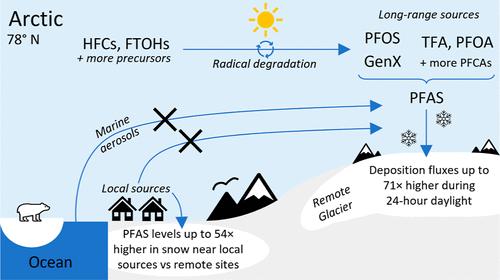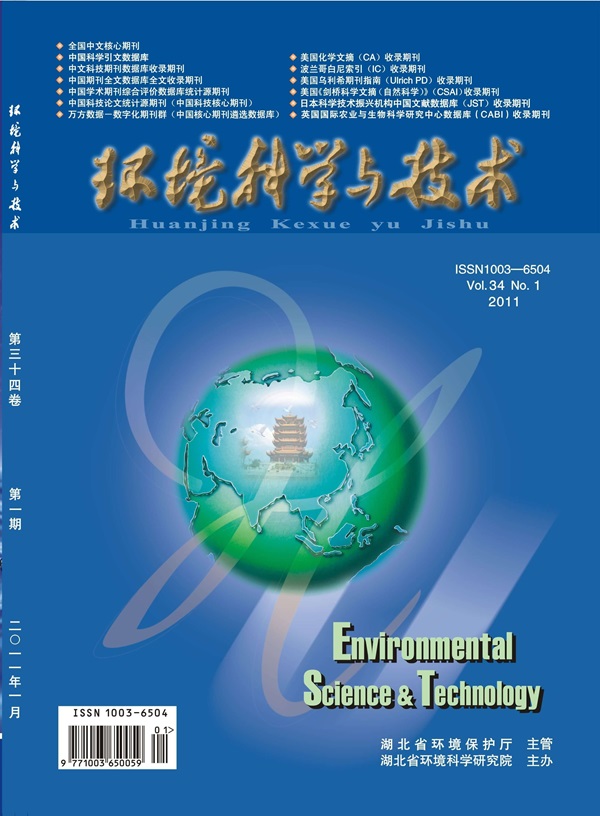Sources and Seasonal Variations of Per- and Polyfluoroalkyl Substances (PFAS) in Surface Snow in the Arctic
IF 11.3
1区 环境科学与生态学
Q1 ENGINEERING, ENVIRONMENTAL
引用次数: 0
Abstract
Per- and polyfluoroalkyl substances (PFAS) are persistent anthropogenic contaminants, some of which are toxic and bioaccumulative. Perfluoroalkyl carboxylic acids (PFCAs) and perfluoroalkyl sulfonic acids (PFSAs) can form during the atmospheric degradation of precursors such as fluorotelomer alcohols (FTOHs), N-alkylated perfluoroalkane sulfonamides (FASAs), and hydrofluorocarbons (HFCs). Since PFCAs and PFSAs will readily undergo wet deposition, snow and ice cores are useful for studying PFAS in the Arctic atmosphere. In this study, 36 PFAS were detected in surface snow around the Arctic island of Spitsbergen during January–August 2019 (i.e., 24 h darkness to 24 h daylight), indicating widespread and chemically diverse contamination, including at remote high elevation sites. Local sources meant some PFAS had concentrations in snow up to 54 times higher in Longyearbyen, compared to remote locations. At a remote high elevation ice cap, where PFAS input was from long-range atmospheric processes, the median deposition fluxes of C2–C11 PFCAs, PFOS and HFPO–DA (GenX) were 7.6–71 times higher during 24 h daylight. These PFAS all positively correlated with solar flux. Together this suggests seasonal light is important to enable photochemistry for their atmospheric formation and subsequent deposition in the Arctic. This study provides the first evidence for the possible atmospheric formation of PFOS and GenX from precursors.

北极表层雪中的全氟和多氟烷基物质 (PFAS) 的来源和季节性变化
全氟烷基和多氟烷基物质(PFAS)是持久性人为污染物,其中一些具有毒性和生物累积性。全氟烷基羧酸(PFCAs)和全氟烷基磺酸(PFSAs)可在氟橡胶醇(FTOHs)、N-烷基化全氟烷基磺酰胺(FASAs)和氢氟碳化合物(HFCs)等前体的大气降解过程中形成。由于 PFCAs 和 PFSAs 很容易发生湿沉积,因此冰雪岩芯对研究北极大气中的 PFAS 非常有用。在这项研究中,2019 年 1 月至 8 月期间(即 24 小时黑夜到 24 小时白天),在北极斯匹次卑尔根岛周围的表层雪中检测到了 36 种 PFAS,这表明污染范围广泛且化学性质多样,包括偏远的高海拔地区。与偏远地区相比,朗伊尔城当地来源的雪中某些全氟辛烷磺酸的浓度要高出 54 倍。在一个偏远的高海拔冰盖,PFAS 的输入来自远距离大气过程,在 24 小时日照期间,C2-C11 全氟辛烷磺酸、全氟辛烷磺酸和全氟辛基膦酸-DA(GenX)的沉积通量中位数高出 7.6-71 倍。这些全氟辛烷磺酸都与太阳通量呈正相关。这表明,季节性光照对于这些物质在北极地区大气中的形成和随后的沉积具有重要的光化学作用。这项研究首次提供了全氟辛烷磺酸和 GenX 可能由前体物质在大气中形成的证据。
本文章由计算机程序翻译,如有差异,请以英文原文为准。
求助全文
约1分钟内获得全文
求助全文
来源期刊

环境科学与技术
环境科学-工程:环境
CiteScore
17.50
自引率
9.60%
发文量
12359
审稿时长
2.8 months
期刊介绍:
Environmental Science & Technology (ES&T) is a co-sponsored academic and technical magazine by the Hubei Provincial Environmental Protection Bureau and the Hubei Provincial Academy of Environmental Sciences.
Environmental Science & Technology (ES&T) holds the status of Chinese core journals, scientific papers source journals of China, Chinese Science Citation Database source journals, and Chinese Academic Journal Comprehensive Evaluation Database source journals. This publication focuses on the academic field of environmental protection, featuring articles related to environmental protection and technical advancements.
 求助内容:
求助内容: 应助结果提醒方式:
应助结果提醒方式:


